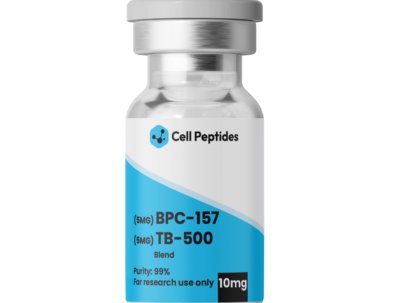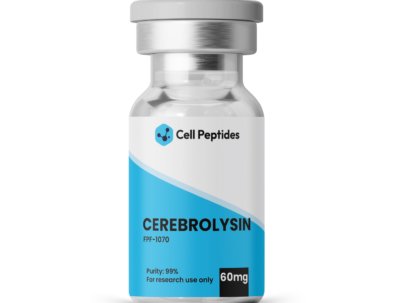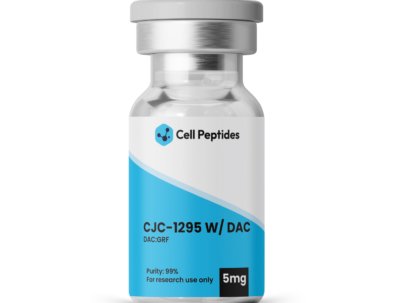- Fast shipping in Europe & USA
- Made in ISO 9001:2015 certified lab
- info@cellpeptides.com
Peptides for tissue healing are gaining attention in biomedical research for their potential to accelerate recovery after injuries. From muscle tears to nerve damage, these compounds are being studied for their effects on regeneration, inflammation control, and cellular repair.
Tissue healing peptides are short-chain amino acid sequences studied for their role in accelerating recovery from injuries and enhancing regeneration across muscle, tendon, ligament, skin, and nerve tissues. This research category is gaining attention for its potential applications in sports medicine, surgical recovery, chronic inflammation, and degenerative disease models.
These peptides are explored for how they support the body’s natural repair processes. Mechanisms include stimulating fibroblast activity, enhancing collagen formation, promoting angiogenesis (new blood vessel growth), and even modulating neuroinflammation for nerve repair. Their effects are being studied in animal models for wound healing, muscle tears, nerve damage, and joint degeneration.
From orthopedic recovery to soft tissue regeneration, tissue-healing peptides represent a promising field of laboratory investigation focused on restoring function and structure after injury. Compounds like BPC-157, TB-500, and GHK-Cu have shown early potential in preclinical studies for their regenerative capabilities.
Important: All peptides discussed here are intended for laboratory research use only. Any effects mentioned are based on preclinical data and are not intended to imply safety or efficacy in humans.
Tissue-healing peptides are short chains of amino acids studied for their ability to support biological repair mechanisms across various tissue types, such as muscle, tendon, nerve, skin, and even internal organs. In preclinical models, these peptides appear to influence key processes such as fibroblast migration, mitochondrial energy output, inflammation control, and oxidative stress reduction.
They are categorized based on their primary functions and research applications:
Together, these compounds represent a promising toolkit in regenerative and repair-focused research, though strictly limited to controlled laboratory environments.
Tissue-healing peptides work through diverse but complementary biological pathways. They are studied across models of injury, inflammation, and degeneration for their role in accelerating repair and enhancing cellular function.
Peptides such as CJC-1295, Ipamorelin, Tesamorelin, and GHRP-6 stimulate the release of growth hormone (GH), which in turn raises IGF-1 levels, both essential for cellular regeneration, muscle repair, and collagen production. Sermorelin specifically targets the pituitary to promote natural GH release and systemic recovery.
BPC-157 is known to enhance blood vessel formation and tendon healing, and has been studied for GI tract repair. TB-500 (Thymosin Beta-4) supports actin regulation, reduces fibrosis, and accelerates soft tissue recovery. PEG-MGF, a PEGylated variant of Mechano Growth Factor, promotes satellite cell activation and muscle regeneration following trauma or intense training.
Neuroactive peptides such as Cerebrolysin, DSIP, Semax, and Selank have shown potential in reducing neuroinflammation, promoting neurotrophic signaling, and aiding in recovery after brain or nerve injury. These peptides are studied in stroke, traumatic brain injury, and neurodegeneration models.
SS-31 (Elamipretide) targets mitochondrial membranes, reducing oxidative damage and restoring cellular energy balance. Epithalon supports telomerase activity and longevity signaling. GHK-Cu enhances skin regeneration and collagen production, while Thymosin Alpha-1 and Thymalin modulate immune response and reduce fibrotic tissue development.
Together, these peptides form a multi-pathway strategy for promoting tissue healing in lab environments.
Tissue-healing peptides have been widely studied in animal models and cell culture systems for their potential to accelerate recovery and reduce tissue damage across a variety of conditions.
BPC-157 has shown consistent results in rodent studies for accelerating tendon, ligament, and even gastrointestinal tract repair. It supports angiogenesis and fibroblast migration, key steps in effective healing.
TB-500 improves muscle fiber density and collagen alignment post-injury, making it a focus in models involving soft tissue trauma and overuse injuries.
PEG-MGF (PEGylated Mechano Growth Factor) has been demonstrated to restore muscle mass in atrophy models and boost recovery after musculoskeletal trauma through satellite cell activation and muscle regeneration.
The combination of CJC-1295 and Ipamorelin has been observed to increase circulating GH and IGF-1 levels in rats, promoting faster post-exercise recovery and tissue repair responses.
Cerebrolysin supports neural recovery by promoting axonal growth and reducing lesion volume in traumatic brain injury models, while DSIP, Semax, and Selank contribute to CNS recovery and stress modulation, improving neurological repair timelines.
SS-31 (Elamipretide) has shown efficacy in protecting mitochondria and restoring ATP levels in ischemic tissue, such as post-heart attack or muscle crush injury, where oxidative stress is high.
GHK-Cu demonstrates wound-healing properties by reducing pro-inflammatory cytokines and supporting collagen production and tissue regeneration in skin and soft tissue injury models.
Epithalon improves cellular repair capacity by activating telomerase and enhancing recovery in oxidative stress models.
Thymalin and Thymosin Alpha-1 help regulate immune cell activity and fibroblast signaling, making them valuable in studies involving wound closure, scar tissue modulation, and immune-compromised healing.
While most findings are limited to preclinical settings, they offer a compelling basis for continued tissue-repair research using these peptides.
The majority of peptides used in tissue-healing research are classified strictly for investigational use and are not approved by the FDA for medical or therapeutic application. While Thymosin Alpha-1 has been used clinically in select countries for immune-related conditions, it is not universally approved for tissue repair or regenerative medicine purposes.
Preclinical studies have noted various physiological responses, including mild water retention, localized inflammation at injection sites, and hormonal fluctuations depending on the compound and dosage used. These observations underscore the need for careful model selection, controlled dosing, and meticulous lab conditions.
Proper laboratory handling is essential. Peptides must be reconstituted using sterile solvents, stored at room temp. and refrigerated when reconstituted, and shielded from moisture, light, and repeated freeze-thaw cycles to maintain stability. pH sensitivity is also a concern for some compounds and should be verified per peptide.
Several peptides stand out in tissue repair research for their regenerative and protective properties across muscle, nerve, skin, and connective tissues. These compounds target key biological pathways like angiogenesis, fibroblast activity, mitochondrial support, and GH/IGF-1 signaling.
Each peptide serves a unique function, offering diverse research possibilities in regenerative medicine. All are strictly intended for laboratory research use only.
When working with tissue-healing peptides in research, proper handling and experimental design are critical to ensure reliable and reproducible outcomes.
Peptide selection should prioritize compounds with ≥98% purity, validated amino acid sequences, and Certificates of Analysis (CoAs). This ensures consistency across assays and accurate interpretation of biological effects.
For reconstitution, most peptides dissolve well in bacteriostatic water.
Dosing varies by study model but often follows established mg/kg ratios in rodent trials. Start with published ranges and adapt based on your experimental design, endpoint sensitivity, and administration route (e.g., subcutaneous, intramuscular).
These peptides are typically applied in injury models, including muscle tears, nerve crush, excisional skin wounds, ischemia-reperfusion, or joint degeneration.
Key outcome endpoints include:
Always follow sterile techniques, maintain detailed documentation, and ensure all protocols are compliant with institutional and ethical lab standards.
Commonly studied peptides include BPC-157, TB-500, and PEG-MGF, each known for supporting regeneration, reducing inflammation, and enhancing muscle fiber repair in preclinical models.
Yes. A frequently researched combination includes CJC-1295 + Ipamorelin + PEG-MGF. This blend targets the GH/IGF-1 axis while promoting direct tissue regeneration.
Most peptides reconstitute effectively with bacteriostatic water.
Use a combination of histological imaging, cytokine profiling, collagen quantification, and biomechanical testing to assess regeneration, inflammation, and tissue integrity.
To sum all the information up, peptides for tissue healing represent a rapidly evolving frontier in biomedical research, offering valuable insights into muscle repair, neuroregeneration, skin recovery, and more. Compounds such as BPC-157, TB-500, CJC-1295, PEG-MGF, and SS-31 are at the forefront of lab-based studies aimed at accelerating recovery and reducing inflammation.
To support your regenerative research, browse the full CellPeptides’ Tissue Healing collection and access high-purity compounds backed by analytical testing down below.
Peptides for Tissue Healing
Peptides for tissue healing are gaining attention in biomedical research for their potential to accelerate recovery after injuries. From muscle tears to nerve damage, these compounds are being studied for their effects on regeneration, inflammation control, and cellular repair.
Tissue healing peptides are short-chain amino acid sequences studied for their role in accelerating recovery from injuries and enhancing regeneration across muscle, tendon, ligament, skin, and nerve tissues. This research category is gaining attention for its potential applications in sports medicine, surgical recovery, chronic inflammation, and degenerative disease models.
These peptides are explored for how they support the body’s natural repair processes. Mechanisms include stimulating fibroblast activity, enhancing collagen formation, promoting angiogenesis (new blood vessel growth), and even modulating neuroinflammation for nerve repair. Their effects are being studied in animal models for wound healing, muscle tears, nerve damage, and joint degeneration.
From orthopedic recovery to soft tissue regeneration, tissue-healing peptides represent a promising field of laboratory investigation focused on restoring function and structure after injury. Compounds like BPC-157, TB-500, and GHK-Cu have shown early potential in preclinical studies for their regenerative capabilities.
Important: All peptides discussed here are intended for laboratory research use only. Any effects mentioned are based on preclinical data and are not intended to imply safety or efficacy in humans.
Tissue-healing peptides are short chains of amino acids studied for their ability to support biological repair mechanisms across various tissue types, such as muscle, tendon, nerve, skin, and even internal organs. In preclinical models, these peptides appear to influence key processes such as fibroblast migration, mitochondrial energy output, inflammation control, and oxidative stress reduction.
They are categorized based on their primary functions and research applications:
Together, these compounds represent a promising toolkit in regenerative and repair-focused research, though strictly limited to controlled laboratory environments.
Tissue-healing peptides work through diverse but complementary biological pathways. They are studied across models of injury, inflammation, and degeneration for their role in accelerating repair and enhancing cellular function.
Peptides such as CJC-1295, Ipamorelin, Tesamorelin, and GHRP-6 stimulate the release of growth hormone (GH), which in turn raises IGF-1 levels, both essential for cellular regeneration, muscle repair, and collagen production. Sermorelin specifically targets the pituitary to promote natural GH release and systemic recovery.
BPC-157 is known to enhance blood vessel formation and tendon healing, and has been studied for GI tract repair. TB-500 (Thymosin Beta-4) supports actin regulation, reduces fibrosis, and accelerates soft tissue recovery. PEG-MGF, a PEGylated variant of Mechano Growth Factor, promotes satellite cell activation and muscle regeneration following trauma or intense training.
Neuroactive peptides such as Cerebrolysin, DSIP, Semax, and Selank have shown potential in reducing neuroinflammation, promoting neurotrophic signaling, and aiding in recovery after brain or nerve injury. These peptides are studied in stroke, traumatic brain injury, and neurodegeneration models.
SS-31 (Elamipretide) targets mitochondrial membranes, reducing oxidative damage and restoring cellular energy balance. Epithalon supports telomerase activity and longevity signaling. GHK-Cu enhances skin regeneration and collagen production, while Thymosin Alpha-1 and Thymalin modulate immune response and reduce fibrotic tissue development.
Together, these peptides form a multi-pathway strategy for promoting tissue healing in lab environments.
Tissue-healing peptides have been widely studied in animal models and cell culture systems for their potential to accelerate recovery and reduce tissue damage across a variety of conditions.
BPC-157 has shown consistent results in rodent studies for accelerating tendon, ligament, and even gastrointestinal tract repair. It supports angiogenesis and fibroblast migration, key steps in effective healing.
TB-500 improves muscle fiber density and collagen alignment post-injury, making it a focus in models involving soft tissue trauma and overuse injuries.
PEG-MGF (PEGylated Mechano Growth Factor) has been demonstrated to restore muscle mass in atrophy models and boost recovery after musculoskeletal trauma through satellite cell activation and muscle regeneration.
The combination of CJC-1295 and Ipamorelin has been observed to increase circulating GH and IGF-1 levels in rats, promoting faster post-exercise recovery and tissue repair responses.
Cerebrolysin supports neural recovery by promoting axonal growth and reducing lesion volume in traumatic brain injury models, while DSIP, Semax, and Selank contribute to CNS recovery and stress modulation, improving neurological repair timelines.
SS-31 (Elamipretide) has shown efficacy in protecting mitochondria and restoring ATP levels in ischemic tissue, such as post-heart attack or muscle crush injury, where oxidative stress is high.
GHK-Cu demonstrates wound-healing properties by reducing pro-inflammatory cytokines and supporting collagen production and tissue regeneration in skin and soft tissue injury models.
Epithalon improves cellular repair capacity by activating telomerase and enhancing recovery in oxidative stress models.
Thymalin and Thymosin Alpha-1 help regulate immune cell activity and fibroblast signaling, making them valuable in studies involving wound closure, scar tissue modulation, and immune-compromised healing.
While most findings are limited to preclinical settings, they offer a compelling basis for continued tissue-repair research using these peptides.
The majority of peptides used in tissue-healing research are classified strictly for investigational use and are not approved by the FDA for medical or therapeutic application. While Thymosin Alpha-1 has been used clinically in select countries for immune-related conditions, it is not universally approved for tissue repair or regenerative medicine purposes.
Preclinical studies have noted various physiological responses, including mild water retention, localized inflammation at injection sites, and hormonal fluctuations depending on the compound and dosage used. These observations underscore the need for careful model selection, controlled dosing, and meticulous lab conditions.
Proper laboratory handling is essential. Peptides must be reconstituted using sterile solvents, stored at room temp. and refrigerated when reconstituted, and shielded from moisture, light, and repeated freeze-thaw cycles to maintain stability. pH sensitivity is also a concern for some compounds and should be verified per peptide.
Several peptides stand out in tissue repair research for their regenerative and protective properties across muscle, nerve, skin, and connective tissues. These compounds target key biological pathways like angiogenesis, fibroblast activity, mitochondrial support, and GH/IGF-1 signaling.
Each peptide serves a unique function, offering diverse research possibilities in regenerative medicine. All are strictly intended for laboratory research use only.
When working with tissue-healing peptides in research, proper handling and experimental design are critical to ensure reliable and reproducible outcomes.
Peptide selection should prioritize compounds with ≥98% purity, validated amino acid sequences, and Certificates of Analysis (CoAs). This ensures consistency across assays and accurate interpretation of biological effects.
For reconstitution, most peptides dissolve well in bacteriostatic water.
Dosing varies by study model but often follows established mg/kg ratios in rodent trials. Start with published ranges and adapt based on your experimental design, endpoint sensitivity, and administration route (e.g., subcutaneous, intramuscular).
These peptides are typically applied in injury models, including muscle tears, nerve crush, excisional skin wounds, ischemia-reperfusion, or joint degeneration.
Key outcome endpoints include:
Always follow sterile techniques, maintain detailed documentation, and ensure all protocols are compliant with institutional and ethical lab standards.
Commonly studied peptides include BPC-157, TB-500, and PEG-MGF, each known for supporting regeneration, reducing inflammation, and enhancing muscle fiber repair in preclinical models.
Yes. A frequently researched combination includes CJC-1295 + Ipamorelin + PEG-MGF. This blend targets the GH/IGF-1 axis while promoting direct tissue regeneration.
Most peptides reconstitute effectively with bacteriostatic water.
Use a combination of histological imaging, cytokine profiling, collagen quantification, and biomechanical testing to assess regeneration, inflammation, and tissue integrity.
To sum all the information up, peptides for tissue healing represent a rapidly evolving frontier in biomedical research, offering valuable insights into muscle repair, neuroregeneration, skin recovery, and more. Compounds such as BPC-157, TB-500, CJC-1295, PEG-MGF, and SS-31 are at the forefront of lab-based studies aimed at accelerating recovery and reducing inflammation.
To support your regenerative research, browse the full CellPeptides’ Tissue Healing collection and access high-purity compounds backed by analytical testing down below.






